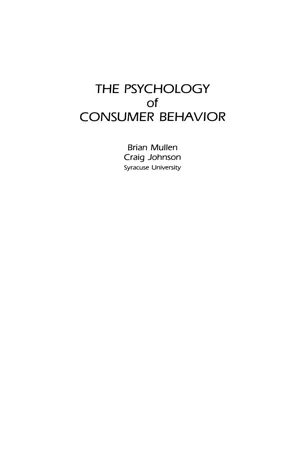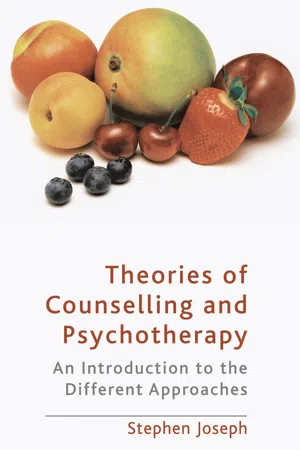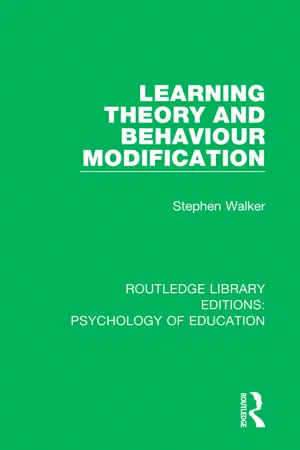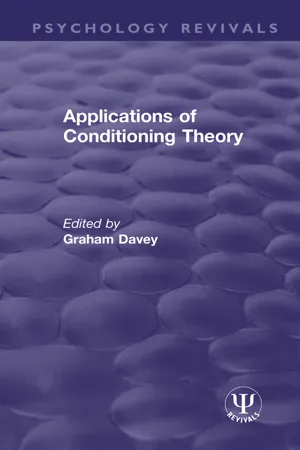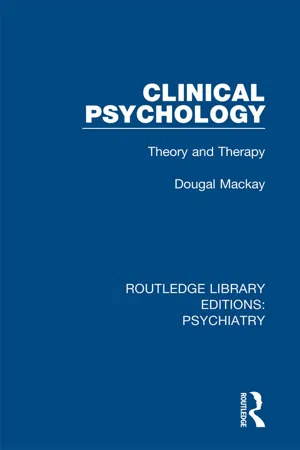Psychology
Application of Classical Conditioning
The application of classical conditioning involves using the principles of association between stimuli to modify behavior. This can be seen in various therapeutic techniques, such as systematic desensitization for treating phobias, and in advertising and marketing to create positive associations with products. Classical conditioning has also been applied in animal training, particularly in the field of behaviorism.
Written by Perlego with AI-assistance
Related key terms
8 Key excerpts on "Application of Classical Conditioning"
- eBook - ePub
- Brian Mullen, Craig Johnson(Authors)
- 2013(Publication Date)
- Psychology Press(Publisher)
In classical conditioning, a response (the conditioned response) comes to be evoked by a previously neutral stimulus (the conditioned stimulus) that has been repeatedly paired with a stimulus (the unconditioned stimulus) that originally elicited the response (the unconditioned response). This model of learning is sometimes referred to as Pavlovian conditioning, after the Russian physiologist Ivan Pavlov (1927) who formalized and developed this model. This model is also sometimes referred to as respondent conditioning, because it is primarily concerned with beliefs that occur in response to some preceding stimulus. Fig. 5.1 illustrates this basic associational process using the typical example of Pavlov’s dog. The presentation of meat powder (the unconditioned stimulus) naturally elicits salivation (the unconditioned response) on the part of the dog. If a bell (the conditioned stimulus) is repeatedly presented immediately before the meat powder, eventually the bell will come to elicit salivation (the conditioned response). This association will become stronger as the number of pairings of the conditioned stimulus and the unconditioned stimulus increases. Contrary to the impression sometimes conveyed in textbooks on consumer behavior (e.g., Assael, 1981), the classical conditioning model is a very powerful means of describing the effects that commercial advertisements can have on consumers (Bierley, McSweeney, & Van Nieuwkerk, 1985; McSweeney & Bierley, 1984; Nord & Peter, 1980). Classical conditioning can be used to explain the development of emotional responses toward a product (see chapter 6), as well as the development of motivational tendencies toward a product (see chapter 7). One illustration of a more general Application of Classical Conditioning is found in a study by Gorn (1982) - eBook - ePub
A History of Psychology
Globalization, Ideas, and Applications
- Robert B. Lawson, E. Doris Anderson, Antonio Cepeda-Benito(Authors)
- 2017(Publication Date)
- Routledge(Publisher)
psychical stimuli . Pavlov came to realize through his studies concerning the pairing of neutral stimuli with feeding that he was working with two types of salivary reflexes, both of which were caused by physiological responses of the nervous system. The foundational physiological response was the unconditioned response (UCR) caused by the natural stimulation of the oral cavity. The second reflex, conditioned responses (CR), could activate areas other than the oral cavities (i.e., eyes, ears, and/or nose; Pavlov, 1955). The next step was to explain the relationship between the two types of responses. He described the paradigm in terms of an unconditioned stimulus (US), a biological stimulus that has the capacity to elicit automatically a reflex activity that yields the UCR, whereas a conditioned stimulus (CS) is a stimulus that was at one time a neutral stimulus but through repeated pairings with the US elicits a CR similar to the UCR. This basic paradigm, as we will see, has been applied to many learning phenomena to explain phenomena such as delayed conditioning, trace conditioning, stimulus conditioning, extinction, spontaneous recovers, disinhibition, stimulus generalization, discrimination, and temperament.Applied Pavlovian Conditioning
Pavlovian conditioning or classical conditioning is no longer viewed strictly as the pairing of a conditioned stimulus with an unconditioned stimulus, but rather involves circumstances around the learning, that is, the context of the learning and other pertinent variables (Rescorla, 1988). An area of psychology that has undergone major changes as well as flourished as a result of the systematic application of the principles of Pavlovian conditioning is psychotherapy. In fact, the work of Rescorla (1988) and others has extended Pavlovian conditioning so that we now have a better understanding, treatment, and even prevention of pathology, especially in the areas of anxiety disorders and drug addiction.Recent theories of panic disorder (PD) with and without agoraphobia (fear of going out of the home) have been based in classical conditioning. Pavlovians argue that the conditioning of anxiety and/or panic to interoceptive (i.e., increased heart rate or lightheadedness) and exteroceptive (i.e., physical location) cues upon exposure to an episode of a panic attack can be understood as emotional conditioning - eBook - ePub
Theories of Counselling and Psychotherapy
An Introduction to the Different Approaches
- Stephen Joseph(Author)
- 2010(Publication Date)
- Bloomsbury Academic(Publisher)
As we have seen in the previous chapter, the argument that there was a need for research into the effectiveness of psychotherapy and counselling came about in part because of criticisms of the psychodynamic model for its unscientific nature and lack of effectiveness as a therapeutic approach (Eysenck, 1952, 1965). In response to Eysenck’s criticisms of psychoanalysis, psychologists began to apply the principles of learning that had been discovered in the laboratory to clinical practice. In contrast to psychoanalysis, which focuses on the internal processes of the person, the behavioural model focuses on the environmental conditions that shape our behaviour. Theorists in the behavioural tradition have emphasized two types of conditioning: classical conditioning and operant conditioning. Ivan Pavlov and classical conditioning Ivan Pavlov (1849–1936), a Russian physiologist, is credited with the discovery of a process called classical conditioning (sometimes called Pavlovian conditioning). Essentially, this is a process of learning by temporal association. Simply, what this means is that if two events occur in close succession they become associated and eventually we come to respond to one as we do to the other. Pavlov (1928) came across this phenomenon while he was studying the digestive process in dogs. As part of his research the dogs were given a meat powder, and Pavlov noticed that after a while the dogs began to salivate when the researchers were about to feed them. Later, it was noticed that the dogs began to salivate when they heard the footsteps of the researchers coming to feed them - eBook - ePub
- Stephen Walker(Author)
- 2017(Publication Date)
- Routledge(Publisher)
3Pavlovian conditioning: reflexes, expectancies and involuntary emotional associations
The development of Pavlov's experimental method of producing conditioned salivation in dogs was described in chapter 1 , and a discussion of Pavlov's application of his findings to the problems of human psychology will be found in chapter 6 . Here I intend to give an up-to-date account of a selection of experiments and theories in the area, which has come to be known as classical conditioning.The descriptive essence of classical conditioning is: first find a stimulus that reliably elicits a certain response from an animal (an unconditioned stimulus, UCS or US). Then we can take another stimulus, which initially does not elicit that response, and set up pairings of the two stimuli, in which the initially ineffective stimulus precedes the effective one. As a consequence, the original response comes to be given to a new stimulus. (The new stimulus is a ‘conditioned stimulus’, or CS, which elicits the conditioned response, CR, a version of the original unconditioned response, the UCR or UR.) Thus, in Pavlov's experiment, dogs which initially salivated when they saw food, but not when they heard buzzers, came to salivate when they heard buzzers after Pavlov, in a special experimental room, had made the buzzer sound as a signal for a few seconds before food was mechanically delivered. This may be called ‘associative learning’ because the response of salivation is now apparently associated with buzzers, whereas it was not to start with. - eBook - ePub
- Graham Davey(Author)
- 2017(Publication Date)
- Routledge(Publisher)
The theories of Pavlovian conditioning adopted by most early behaviour therapists were breathtakingly simple and straight-forward. One position derived from the work of Pavlov was that associations were formed between stimuli: in a sense the CS came to be a substitute for the UCS, and the CR a miniature version of the UCR. The preceding discussion leads inevitably to the conclusion that the application of this simple interpretation of Pavlovian principles in the treatment of fear and anxiety lacks convincing empirical support. Despite the modest success of therapies derived from Pavlovian principles there are just too many inconsistencies to inspire confidence in the adequacy of this model of human behaviour.To make matters worse, many learning theorists have even questioned the status of Pavlovian conditioning as a distinct form of learning. The main threat to Pavlovian conditioning has come from its powerful neighbour – operant conditioning. Pavlovian conditioning involves the pairing of two stimuli without regard to the subject's behaviour. Operant conditioning involves the delivery of a reinforcing stimulus contingent on the subject's behaviour. The experimental operations in the two kinds of conditioning procedure are, therefore, quite distinct; but it does not necessarily follow that they represent different conditioning processes.Indeed the many similarities between the effects of Pavlovian and operant contingencies encourage the view that there is only one underlying process. There is a surprising degree of congruence in the events occurring in the demonstrations of the two conditioning procedures. There are obvious parallels between the CS and discriminative stimuli, also between the UCS and the operant reinforcer, and the occurrence of the responses measured as an index of learning. The phenomena of acquisition, extinction after the with-drawal of reinforcement, spontaneous recovery, generalization and discrimination are all common to both kinds of conditioning procedure. It is scarcely surprising then, that many early theorists (e.g. Hull and Guthrie) blurred any distinction they may have felt tempted to draw between operant and Pavlovian procedures: they refer to both simply as 'conditioning'. - Nancy Fenton, Jessica Flitter(Authors)
- 2015(Publication Date)
- Research & Education Association(Publisher)
Before classical conditioning can occur, an unconditioned stimulus will result in an unconditioned response. This pairing provides the basis for learning through classical conditioning. The neutral stimulus, which will become the conditioned stimulus, is neutral at this time and does not produce any reflexive response. During the second stage, the neutral stimulus is repeatedly paired with the unconditioned stimulus until it becomes the conditioned stimulus. In the final stage of classical conditioning, the conditioned stimulus will produce a conditioned response without the presence of the unconditioned stimulus. The three stages of classical conditioning are identified and applied to Pavlov’s classic experiment in Table 8.2. Table 8.2. Three Stages of Classical Conditioning in Pavlov’s Classic Experiment During his research Ivan Pavlov discovered that the effectiveness of classical conditioning related to a variety of factors, including the frequency (number of times) of the pairings and the timing of when each stimulus was presented. Pavlov discovered that responses would be strengthened if the NS and UCS were paired together more often. Although there are a variety of procedures for presenting stimuli in classical conditioning, research has determined that introducing the NS (which will become the CS) immediately before the UCS will result in the most effective learning. In addition, the amount of time between presenting the NS and UCS is most effective if the interval is between half a second and a few seconds. Several different procedures for pairing stimuli and their application to Pavlov’s research are listed in Table 8.3. Table 8.3- eBook - ePub
Learning & Behavior
Eighth Edition
- James E. Mazur(Author)
- 2016(Publication Date)
- Routledge(Publisher)
Chapter 3 Basic Principles of Classical ConditioningLearning ObjectivesAfter reading this chapter, you should be able to- describe the procedure of classical conditioning and some of the most common ways it is studied in the laboratory
- explain Pavlov’s stimulus substitution theory, and describe its strengths and weaknesses
- describe the basic principles of classical conditioning, including acquisition, extinction, spontaneous recovery, conditioned inhibition, generalization, and discrimination
- explain how the timing of the stimuli in classical conditioning affects the results
- give examples of classical conditioning that are found in everyday life
- describe some behavior therapies that are based on classical conditioning, and evaluate their effectiveness
Pavlov’s Discovery and Its Impact
The Russian scientist Ivan Pavlov is one of the most famous figures in the history of psychology. Pavlov was interested in the various substances secreted by an animal’s digestive system to break down the food eaten, including saliva. He used dogs in his research, and he developed a surgical technique that enabled him to redirect the saliva from one of the dog’s salivary ducts through a tube and out of the mouth, so that it could be measured (see Figure 3.1 ). A dog might receive several test sessions on successive days. In each session the animal would be given food, and its salivation would be recorded as it ate. Pavlov’s important observation came when studying dogs that had been through the testing procedure several times. Unlike a new dog, an experienced one would begin to salivate even before the food was presented. Pavlov reasoned that some stimuli that always preceded the presentation of food, such as the sight of the experimenter, had developed the ability to elicit the response of salivation. Pavlov concluded that his dogs were exhibiting a simple type of learning: Salivation, which began as a reflexive response to the stimulus of food in the dog’s mouth, was now elicited by a new stimulus. This phenomenon is now known as classical conditioning - eBook - ePub
Clinical Psychology
Theory and Therapy
- Dougal Mackay(Author)
- 2018(Publication Date)
- Routledge(Publisher)
unconditioned response (UCR). The two important features to note about this form of conditioning are that the organism is passive throughout, and that the model is limited to dealing with autonomic patterns of response (e.g. anxiety, salivation, sexual arousal).The classic case of the eleven-month-old boy. Little Albert (Watson and Raynor, 1920); provides, a clear illustration of how a phobia can be created through classical conditioning. Quite simply, Albert developed a‘phobia ’of white rats after one had been paired on several occasions with a loud noise, caused by striking an iron bar. In this study, the rat is the CS, the noise the UCS, and the anxiety the UCR. In keeping with Pavlov’s principle of response generalization, Albert also displayed anxiety in the presence of other furry animals as a result of the experiment. Since the ‘phobia’ persisted for over a month, it is claimed by behaviourists to be analogous to the ‘neurotic fears’ observed in the clinic.Classical conditioning is also assumed to play an important part in determining sexual orientation. An experiment conducted by Rachman (1966) demonstrates how fetishism can be created in the laboratory by means of this particular learning paradigm. A photograph of a pair of black, knee-length boots (CS) was repeatedly shown just before slides of sexually provocative nudes (UCS). Before the experiment began, it had been demonstrated that penile volume increased (UCR) in response’ to the nudes but not to the boots. As a result of the association which built up between the two types of stimuli, the subjects learned eventually to respond sexually to the picture of the boots. The response also generalized to other types of women’s footwear.One serious limitation of the classical conditioning paradigm is that whereas it may explain how phobias and sexual deviations can arise, it cannot explain why they continue over time. One of Pavlov’s important findings was that, if the CS is presented on a number of occasions without the UCS, then the CS will gradually lose its arousing properties until eventually complete extinction of the response takes place (see A3). Why is it, therefore, that phobias persist? The answer to this question is twofold. In the first place there is evidence (e.g. Eysenck and Rachman, 1965) that the majority of conditioned anxiety responses do extinguish eventually (spontaneous recovery). The second part of the answer takes account of the fact that there is one crucial life between and the man in the street: the man can choose not to go into situations which would facilitate extinction, whereas the harnessed laboratory animal is denied such a choice. The learning paradigm for understanding voluntary behaviour of this sort is called instrumental or operant conditioning
Learn about this page
Index pages curate the most relevant extracts from our library of academic textbooks. They’ve been created using an in-house natural language model (NLM), each adding context and meaning to key research topics.
